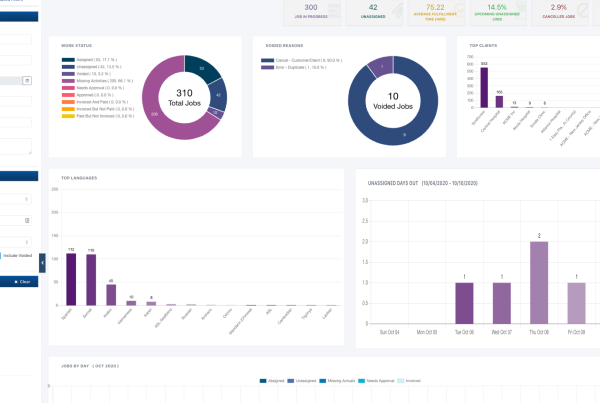Do We Need a System or a Platform to Manage Translation?
When it comes to managing translation, is it necessary to use a system or platform? Yes, having a system or platform optimizes the process. However, you don’t have to host or manage it. If you have different types of content, or different departments creating content, it is best to manage your multilingual content in an organized and structured fashion.
These are the seven main reasons why you need a platform to manage translation and multilingual content:
- 1. Project Management:
Advanced Translation Management Platforms will give you a client portal dedicated to your organization. This portal is customized for your different projects and content types, and translation-related services. It is much easier to manage projects online in an easy-to-use interface customized to your organization needs. Good platforms will also allow you and your translation partner to develop custom workflows for each type of project or content. These pre-defined project workflows customized to your multilingual needs ensure each required step is completed, from approving the spend to storing the final work product.
Quotation and approval processes are integral parts of each project. Using defined user profiles (see number 5, below) and customized workflows ensures the right members of your team timely review, reply, accept, or reject proposals in the system to keep the translation process moving forward appropriately.
- 2. Consolidation:
Consolidation is vital when it comes to your organization’s brand consistency, intellectual Property (IP), and tone of voice. If you want all your employees/associates to use the same languages and terms, then you need to consolidate your linguistic assets and multilingual content in one location. The best option for this is an online secured platform.
Consolidation not only helps with brand consistency, but also with standardizing the translation management process. When all teammates use the same system and follow pre-defined processes, the outcomes are necessarily more consistent.
- 3. Visibility and Control:
In a platform environment you will have access to all the information you need to make informed decisions. You will see who is translating what, when, and how. You will see who is spending how much on what and when. It will allow you to set thresholds for the spend per department, cost center, or even type of content.
Self-serve reports and real time data is crucial for today’s business. You should seek a platform that has both quantitative and qualitative reporting capabilities that will help you with calculating your return on investment (ROI). It should also allow you to see the status of your projects in real time, and how they are progressing.
- 4. Collaboration:
Your content is one of your biggest assets. It represents your know-how, your innovations, your strategy, and more. Converting this wealth into other languages is a collaborative effort between you, your subject matter experts, your multilingual solutions partner, and linguists. It is very important to ensure open communication channels between these players to guarantee that all your messages, meanings, concepts, and ideas are transformed into other languages and cultures.
The platform should allow for flawless communications on all levels: project management, linguistic questions, proposals, approvals, and technical discussions.
- 5. Roles, Responsibilities, and Access/Approval Rights:
Based on a good understanding of your strategy, internal structure, and processes, a unique set of user profiles can be created in the platform to allow specific users to do specific things. You can decide which users see which content or projects, decide which users have authority to submit new projects, who can approve proposals, and whether users are limited to their own projects or can view or even make decisions on projects at a departmental or even organizational level.
The best platforms even incorporate your internal subject matter experts directly into the process. For example, if you have internal subject matter experts with linguistic backgrounds, you can have them access linguistic assets to review or sign-off on the content or quality.
- 6. File Management:
Today’s content is stored in many different file formats and inside a variety of content management systems. And of course, you have to have the right software or application to open certain file types. In addition, today’s files aren’t measured in kilobytes; they are in mega or gigabytes. A single translation project can have tens or hundreds of files, so managing and storing them manually is just not a viable option.
A translation management platform allows you to create projects and add as many files as you have, with any size, without a limit. The platform will keep files organized by project or product, and manage different versions.
A robust platform will support just about any file format from text processing to code files, design packages to web pages and mobile resources, complex multi-media presentations, and more, without the need to convert the content from one format to another then revert it back after translation.
- 7. Integrability:
Some people do not consider “integrability” a real word, but it is at least a true concept. A modern platform must be able to integrate with, or “talk” to other systems. “Talking” could be as simply as exchanging data on the status of ongoing projects to more complex content exchange and even full-blown integration.
With big data, blockchain, and internet of things, content is becoming more and more liquid. Content often can’t be contained in a “file,” but is rather contained in structures that follow data models and is stored in various types of databases.
The best translation platforms have an open Application Programming Interface (API) to be able to communicate and/or integrate with other systems like content, document, learning management systems, or even proprietary systems. Such systems allow the multidirectional secured flow of content and/or information between various systems, potentially in real-time. A comprehensive translation management platform will also support artificial intelligence, and integration with machine translation systems (aka, “automated translation systems”).
Finding the best translation management platform to suit your organization’s unique needs might seem daunting. But here’s the best part: you don’t have to develop, host, or manage a translation management system/platform. Rather, you simply need to partner with a good multilingual solutions provider that has a platform in place ready to customize to fit current and future needs. Connect with us today to learn more!









